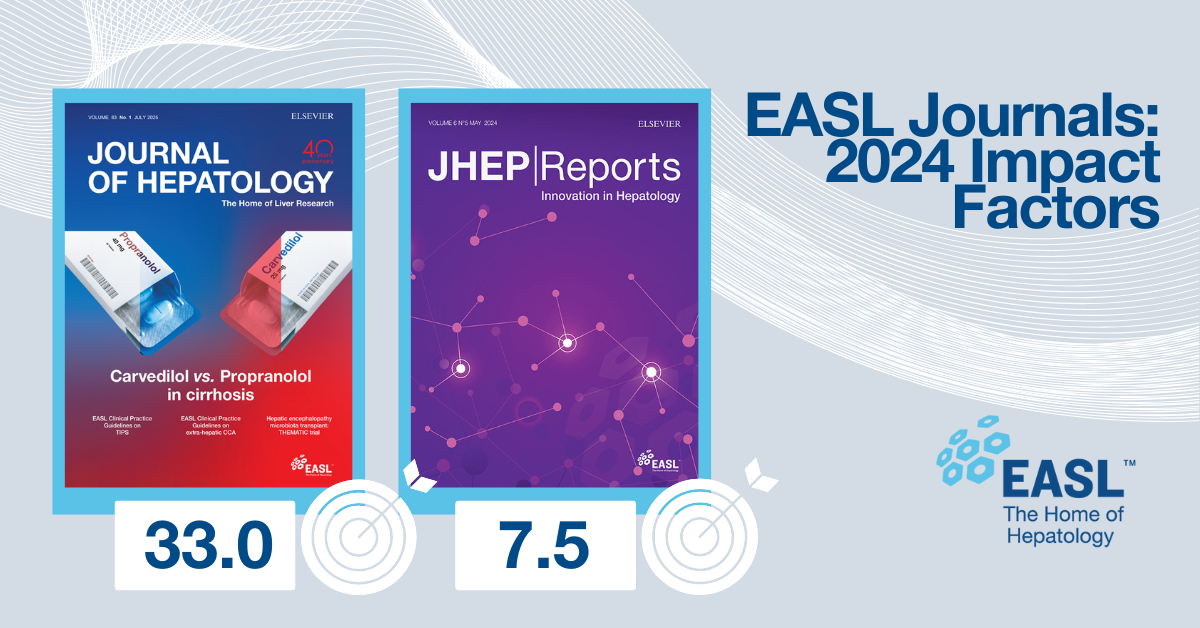EASL celebrates new Impact Factors 2024 for Journal of Hepatology and JHEP Reports

EASL is proud to announce that both of its journals have achieved outstanding new impact factors, as released in the 2025 Journal Citation Reports (JCR) by ClarivateTM.
The Journal of Hepatology, EASL’s flagship publication, has reached a record-high Impact Factor of 33.0, reinforcing its status as the leading journal in hepatology. This continued upward trajectory is a clear indication of its influence and relevance in the field, and its steadfast commitment to scientific excellence.
Editor-in-Chief Prof. Vlad Ratziu commented: “The entire editorial team is proud and honoured to see the level of recognition that the Journal of Hepatology has achieved, and which is reflected in its highest impact factor to date. We owe this achievement to the authors, the reviewers for their steadfast dedication, and the associate editors whose knowledge and vision guide the journal. We are excited to continue being at the cutting edge of scientific knowledge in hepatobiliary diseases while providing the best educational value in each one of our monthly issues.”
Meanwhile, JHEP Reports, EASL’s open-access journal, has achieved an impact factor of 7.5, solidifying its place among top publications in the field. The new impact factor reflects the journal’s ability to consistently publish high-quality research that resonates with the global hepatology community and contributes meaningfully to scientific progress.
Editor-in-Chief Prof. Josep M. Llovet stated: “Our 2025 Impact Factor is 7.5, this firmly establishes our journal among the top publications in hepatology. We are confident JHEP Reports will keep growing, backed by our excellent editorial team and initiatives such as publishing top-quality reviews, launching our new section Top research outside JHEP Reports, and working with EASL on official publications. We thank our editors, reviewers and readers for their continued support.”
EASL extends its deepest thanks to the editorial boards, dedicated peer reviewers and the global research community whose trust and support have been essential to the success of both journals.
These achievements reflect EASL’s ongoing commitment to advancing liver research, supporting high-quality scientific publishing and fostering global collaboration in hepatology.
About the Journal of Hepatology
The Journal of Hepatology is a monthly, English language, peer-reviewed journal. First published in 1985 as the official journal of EASL, it provides an international forum for the publication of original articles, reviews and letters to the Editor describing basic laboratory, translational, and clinical investigations in hepatology. All articles undergo a rigorous peer review and are selected based on the originality of the findings, the superior quality of the work described, and the clarity of presentation.
Getting the Daniel Alagille Award has had a significant impact on my career. It has enhanced my recognition on an international level, allowing me to connect with other researchers in the field. Especially, the opportunity to attend my first EASL Congress in Amsterdam! As a group, we are now able to raise more awareness about Aagenaes syndrome, which is crucial both now and for the future. This recognition not only validates our hard work but also empowers us to push the boundaries of our research further.
About JHEP reports
JHEP Reports is an open-access companion title to the highly-respected Journal of Hepatology. It publishes original papers, reviews, and letters to the Editor concerned with basic, translational, and clinical research in the field of hepatology. JHEP Reports is an innovative journal publishing articles on global issues in hepatology, with specific focus on clinical trials, novel diagnostics, precision medicine and therapeutics, cellular and molecular research, metabolism, cancer, microbiome, systems biology, epidemiology, and biotechnology advances and devices.

